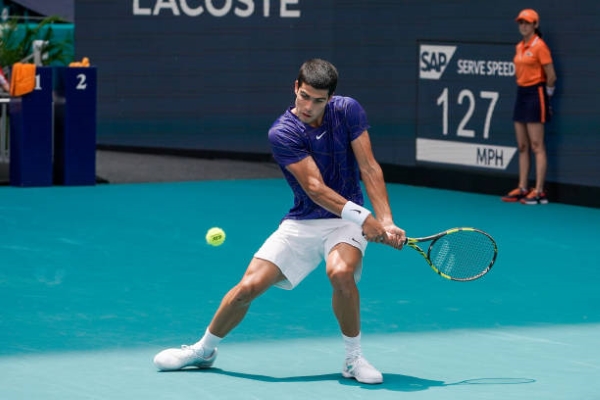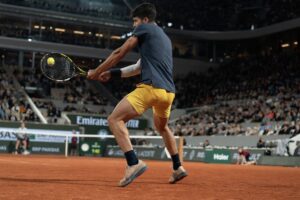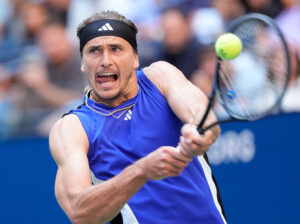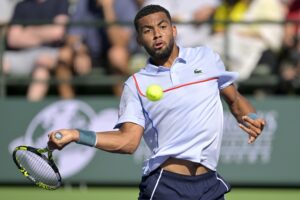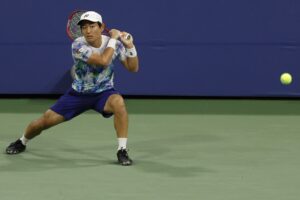Ahead of the start of the men’s European clay court season this Sunday in Monte Carlo, the biggest question in tennis is whether this year’s breakout star, 18-year-old Carlos Alcaraz, can compete on clay against what might now be called (in the continuing absence from the ATP Tour of Roger Federer) “The Big Two”, namely Rafael Nadal and Novak Djokovic. On the evidence of the 2022 season so far, which Alcaraz has virtually dominated (especially after Nadal’s injury woes), the answer is surely yes.
Indeed, the real question might be whether the brilliant young Spaniard can compete so effectively against Nadal and Djokovic that he is a realistic contender for the French Open title. Again, on the evidence of his remarkable season so far, the answer must also be yes – a more tentative one, perhaps, but nevertheless yes.
It’s Been Alcaraz’s Year So Far
2022 had looked like it would be Nadal’s year, indeed his own annus mirabilis to rank alongside those of Djokovic (2011) and Federer (2017). He was unbeaten for the first couple of months, which encompassed both the historic Australian Open win that gave him a record 21st Major and two other tournament victories (in a warm-up event for the Australian Open and in Acapulco). And when he defeated Alcaraz, his much younger compatriot, in a truly epic semifinal at Indian Wells that is probably the best men’s match of the year so far, it was certainly possible to envisage him winning a 14th French Open title and even, perhaps, emulating Djokovic in 2021 and challenging for the Calendar Grand Slam.
Then, however, as the former British Prime Minister Harold McMillan so famously opined, “events” intervened. Nadal beat Alcaraz in Indian Wells, but arguably it was a pyrrhic victory as he suffered a broken rib in the process, which ultimately left him unable to compete properly in the Indian Wells final against Taylor Fritz, who duly won his first ATP Masters 1000 event, and eventually led to Nadal taking a complete break from the tour to recover. Given his horrendous injury record over the years, it should perhaps have come as no surprise. However, given his astonishing start to the season, it was still profoundly disappointing both for the great Spaniard and his many fans.
In Nadal’s absence in Miami and the ongoing absence of Djokovic, who continues to put his “principles” about Covid vaccination above his chances of winning another tennis tournament of any description let alone a Major, Alcaraz reasserted himself as the player of the year so far. Having already won his first ATP500 Event in Rio, when he defeated three current or former top 10 players (Matteo Berrettini, Fabio Fognini and Diego Schwarzman) in a little over 48 hours to claim the title, he then improved upon that remarkable feat in Florida by beating three current top-10 players (Stefanos Tsitsipas, Hubert Hurkacz and Casper Ruud) in succession to claim his first ATP Masters 1000 event.
Arguably, Alcaraz’s performance after the final match in Miami was even more impressive than his on-court brilliance, as he took all the questions about his future prospects completely in his stride. As he told the Amazon Prime Video interviewers – Marcus Buckland, Tim Henman and Daniela Hantuchova – immediately afterwards, “First ATP500 in February…First ATP1000 in April…so, perhaps in June a Major?” He exhibited supreme confidence, not cockiness, and justifiably so, given that in Miami he had shown enough to suggest that he is arguably the best 18-year-old male tennis player there has ever been, even ahead of luminaries such as Nadal, Becker and McEnroe. The first two of those may have won Majors before they were as old as Alcaraz is now, but at that early point in their career they did not yet have the complete all-court game that Alcaraz already possesses.
But Nadal And Djokovic Remain Huge Obstacles
Nevertheless, there is no doubting the scale of the challenge that lies ahead for Alcaraz if he is to win a major clay-court title this season, let alone a Major title in Paris. In Nadal and Djokovic, he will face unarguably the greatest clay-court player ever and arguably the second greatest clay-court player ever. Between them, they have won all but two of the last 18 Roland Garros titles (the exceptions being in 2009, when Federer won, and 2015, when his compatriot Stan Wawrinka triumphed). And only last year they played out arguably the greatest men’s clay-court match ever in the French Open semifinal, when Djokovic somehow won a truly titanic third set and eventually edged Nadal out in four sets.
Furthermore, both Nadal and Djokovic, being the supreme competitors that they are, may regard the rise of Alcaraz as a personal affront to their own greatness. As he recovers from his broken rib, Nadal may just be enjoying an enforced period of rest before Roland Garros. And Djokovic is, as it were, the ultimate “Screw-You” player, the man who loves to stick it to the world when it writes him off, as it did during the Federer-Nadal duopoly of the late noughties and again when he lost his mojo halfway through his decade of domination in the last decade. Now that he is being questioned yet again, because of his almost complete lack of match play this year, he will surely rise to the challenge yet again.
An Inter-Generational Challenge Awaits
Consequently, a genuinely inter-generational challenge lies ahead in men’s tennis, beginning with the 2022 European clay court season, as a rapidly rising star (Alcaraz) competes against two of the three greatest male tennis players ever (Nadal and Djokovic). Such inter-generational battles are rare in all of sport, let alone tennis. An obvious one that springs to mind is when the 21-year-old Roger Federer defeated seven-times Wimbledon champion Pete Sampras in the fourth round at Wimbledon in 2001. However, whereas that was a one-time-only classic, the most thrilling thing about Alcaraz versus Nadal and Djokovic is that it could be played out over the course of an entire clay-court season, before possibly coming to a crescendo in Paris in early June. If that does come to pass, it will truly be a battle for the ages, between two different ages of men’s tennis.
Main photo:
Embed from Getty ImagesEmbed from Getty Images


